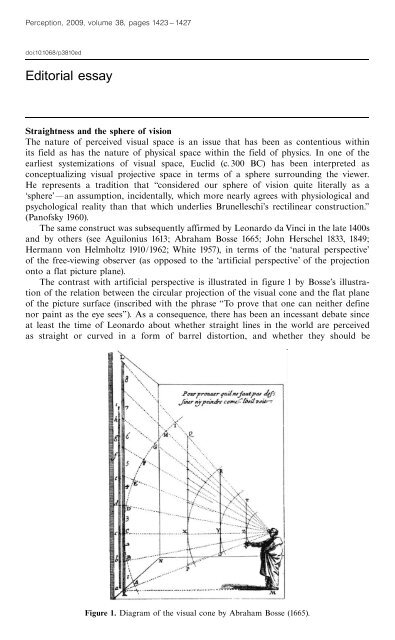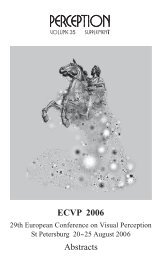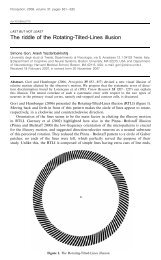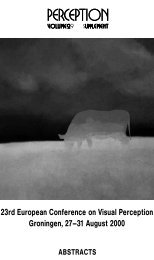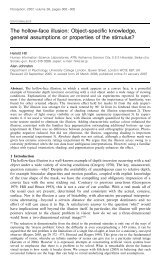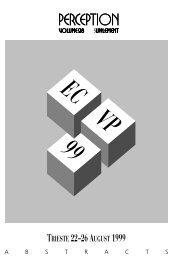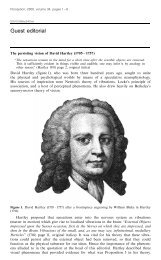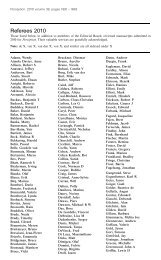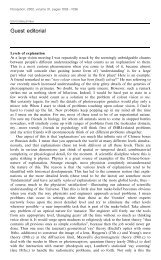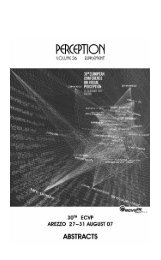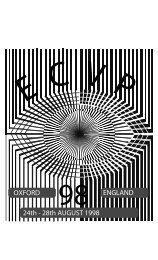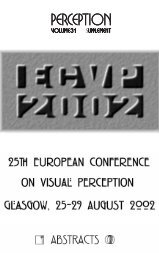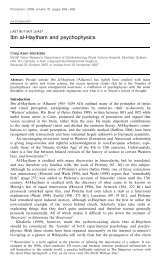Straightness and the Sphere of Vision - Smith-Kettlewell Eye ...
Straightness and the Sphere of Vision - Smith-Kettlewell Eye ...
Straightness and the Sphere of Vision - Smith-Kettlewell Eye ...
You also want an ePaper? Increase the reach of your titles
YUMPU automatically turns print PDFs into web optimized ePapers that Google loves.
Perception, 2009, volume 38, pages 1423 ^ 1427<br />
doi:10.1068/p3810ed<br />
Editorial essay<br />
<strong>Straightness</strong> <strong>and</strong> <strong>the</strong> sphere <strong>of</strong> vision<br />
The nature <strong>of</strong> perceived visual space is an issue that has been as contentious within<br />
its field as has <strong>the</strong> nature <strong>of</strong> physical space within <strong>the</strong> field <strong>of</strong> physics. In one <strong>of</strong> <strong>the</strong><br />
earliest systemizations <strong>of</strong> visual space, Euclid (c. 300 BC) has been interpreted as<br />
conceptualizing visual projective space in terms <strong>of</strong> a sphere surrounding <strong>the</strong> viewer.<br />
He represents a tradition that ``considered our sphere <strong>of</strong> vision quite literally as a<br />
`sphere'öan assumption, incidentally, which more nearly agrees with physiological <strong>and</strong><br />
psychological reality than that which underlies Brunelleschi's rectilinear construction.''<br />
(Pan<strong>of</strong>sky 1960).<br />
The same construct was subsequently affirmed by Leonardo da Vinci in <strong>the</strong> late 1400s<br />
<strong>and</strong> by o<strong>the</strong>rs (see Aguilonius 1613; Abraham Bosse 1665; John Herschel 1833, 1849;<br />
Hermann von Helmholtz 1910/1962; White 1957), in terms <strong>of</strong> <strong>the</strong> `natural perspective'<br />
<strong>of</strong> <strong>the</strong> free-viewing observer (as opposed to <strong>the</strong> `artificial perspective' <strong>of</strong> <strong>the</strong> projection<br />
onto a flat picture plane).<br />
The contrast with artificial perspective is illustrated in figure 1 by Bosse's illustration<br />
<strong>of</strong> <strong>the</strong> relation between <strong>the</strong> circular projection <strong>of</strong> <strong>the</strong> visual cone <strong>and</strong> <strong>the</strong> flat plane<br />
<strong>of</strong> <strong>the</strong> picture surface (inscribed with <strong>the</strong> phrase ``To prove that one can nei<strong>the</strong>r define<br />
nor paint as <strong>the</strong> eye sees''). As a consequence, <strong>the</strong>re has been an incessant debate since<br />
at least <strong>the</strong> time <strong>of</strong> Leonardo about whe<strong>the</strong>r straight lines in <strong>the</strong> world are perceived<br />
as straight or curved in a form <strong>of</strong> barrel distortion, <strong>and</strong> whe<strong>the</strong>r <strong>the</strong>y should be<br />
Figure 1. Diagram <strong>of</strong> <strong>the</strong> visual cone by Abraham Bosse (1665).
1424 Editorial essay<br />
depicted as straight in <strong>the</strong> picture plane <strong>of</strong> <strong>the</strong> artist's canvas. Both Pan<strong>of</strong>sky (1924)<br />
<strong>and</strong> Gombrich (1972), for example, argued that straight lines in natural perspective are<br />
ultimately curved, <strong>and</strong> Herschel (1849), Escher (1947ösee Ernst 1976), <strong>and</strong> White<br />
(1957) developed formal schemes for <strong>the</strong> definition <strong>of</strong> curved perspective, approximating<br />
<strong>the</strong> projective geometry <strong>of</strong> <strong>the</strong> extreme wide-angle or `fish-eye' lens. Later authors<br />
(Pirenne 1970; Hansen 1973; Anstis 1998; Liu <strong>and</strong> Schor 1998; Oomes et al 2009;<br />
Rogers <strong>and</strong> Rogers 2009) have also discussed <strong>the</strong> issue <strong>of</strong> <strong>the</strong> apparent curvature <strong>of</strong><br />
physically straight lines.<br />
A clear statement <strong>of</strong> <strong>the</strong> natural perspective concept may be found in Herschel's<br />
(1849) Outlines <strong>of</strong> Astronomy:<br />
``In celestial perspective, every point to which <strong>the</strong> view is for <strong>the</strong> moment directed, is equally<br />
entitled to be considered as <strong>the</strong> `centre <strong>of</strong> <strong>the</strong> picture', every portion <strong>of</strong> <strong>the</strong> surface <strong>of</strong><br />
<strong>the</strong> sphere being similarly related to <strong>the</strong> eye. Moreover, every straight line (supposed to be<br />
indefinitely prolonged) is projected into a semicircle <strong>of</strong> <strong>the</strong> sphere, that, namely, in which<br />
a plane passing through <strong>the</strong> line <strong>and</strong> <strong>the</strong> eye cuts its surface. And every system <strong>of</strong> parallel<br />
straight lines, in whatever direction, is projected into a system <strong>of</strong> semicircles <strong>of</strong> <strong>the</strong><br />
sphere, meeting in two common apexes, or vanishing points, diametrically opposite to each<br />
o<strong>the</strong>r'' (citation acquired from online version).<br />
The implication <strong>of</strong> such perspective schemes is that lines that are straight in <strong>the</strong><br />
world should not necessarily be perceived as straight by <strong>the</strong> viewer. The issue had been<br />
taken up experimentally by Helmholtz (1910/1962), who observed that <strong>the</strong> lines in a<br />
large-visual-angle grid seemed to curve inwards in <strong>the</strong> far periphery. This result is most<br />
easily checked by looking down at a tile floor in a large building (such as an airport).<br />
In <strong>the</strong> context <strong>of</strong> <strong>the</strong> eye moving around to explore <strong>the</strong> environment, a natural definition<br />
<strong>of</strong> straightness is <strong>the</strong> path followed by <strong>the</strong> eye as it moves between two points.<br />
Such motions are determined by <strong>the</strong> space-orientation <strong>of</strong> <strong>the</strong> axis around which <strong>the</strong><br />
eye rotates, which is governed by Listing's law.<br />
The question raised by Helmholtz was: what line geometry provides <strong>the</strong> ocular motion<br />
path for lines in <strong>the</strong> visual periphery, ie lines that do not pass through <strong>the</strong> fovea?<br />
Geometrically, <strong>the</strong> answer is direction circles (Klu« ster 1876; Helmholtz 1910/1962;<br />
Simonsz <strong>and</strong> Den Tonkelaar 1990), which have <strong>the</strong> property <strong>of</strong> being circles inscribed<br />
on <strong>the</strong> visual sphere that all converge to pass through <strong>the</strong> `occipital point', or <strong>the</strong> point<br />
directly behind <strong>the</strong> viewer opposite <strong>the</strong> fixation point (figure 2). Direction circles are<br />
thus not great circles unless <strong>the</strong>y pass through <strong>the</strong> fovea (along any meridian). Relative<br />
to <strong>the</strong>se great circles, <strong>the</strong> o<strong>the</strong>r direction lines may be considered to be curved, but<br />
<strong>the</strong>y will all remain self-congruent as <strong>the</strong> eye is rotated (as long as <strong>the</strong> rotation adheres<br />
to <strong>the</strong> minimum-energy principle <strong>of</strong> Listing's law). The direction circles thus correspond<br />
to a visual version <strong>of</strong> <strong>the</strong> principle <strong>of</strong> conservation <strong>of</strong> energy, first enunciated by<br />
Helmholtz (1847). They correspond to <strong>the</strong> spatial invariants, or null distortion field, for eye<br />
transformation under minimum-energy conditions.<br />
As such, <strong>the</strong> direction circles form a kind <strong>of</strong> invariance `horopter' for a given<br />
direction <strong>of</strong> eye-movement transformation, which in physics terminology would be<br />
termed <strong>the</strong> invariance domains <strong>of</strong> <strong>the</strong> minimum-energy rotational group. There is thus<br />
considerable interest in determining whe<strong>the</strong>r <strong>the</strong> visual perception <strong>of</strong> straightness<br />
conforms to this combination <strong>of</strong> minimum-energy principles. The reason that <strong>the</strong><br />
spherical issue enters <strong>the</strong> question <strong>of</strong> natural perspective is that <strong>the</strong> eye cannot translate<br />
across a surfaceö<strong>the</strong> eye can only rotate about its center. A person can translate<br />
through <strong>the</strong> world (although only with some difficulty, unless he/she is on a moving<br />
vehicle). However, natural perspective is more typically associated with <strong>the</strong> stationary<br />
observer with a moving eye, which is capable only <strong>of</strong> rotation. It is this distinction that<br />
brings <strong>the</strong> direction lines into play as <strong>the</strong> c<strong>and</strong>idate invariants for natural perspective.
Editorial essay 1425<br />
y<br />
occipital<br />
point<br />
direction<br />
circle<br />
x<br />
z<br />
Figure 2. Ocular rotation circles, known as `direction circles' <strong>and</strong> <strong>the</strong>ir projection to a frontoparallel<br />
plane. From Rogers <strong>and</strong> Rogers (2009).<br />
Indeed, Pan<strong>of</strong>sky (1924) mentions that <strong>the</strong> curved retina is a key reason for expecting<br />
straight lines to be curved in natural perspective. However, <strong>the</strong> preceding development<br />
has said nothing about <strong>the</strong> shape <strong>of</strong> <strong>the</strong> retina, <strong>and</strong> is framed purely in terms <strong>of</strong> <strong>the</strong><br />
operational invariants <strong>of</strong> <strong>the</strong> optic array. On this view, it is not <strong>the</strong> curvature <strong>of</strong><br />
<strong>the</strong> retina that is relevant, but <strong>the</strong> sphericity <strong>of</strong> <strong>the</strong> eye that determines <strong>the</strong> form <strong>of</strong> <strong>the</strong><br />
invariants by constraining its motion to rotation around a point <strong>and</strong> adherence to<br />
Listing's law controlling <strong>the</strong> rotation axis for trajectories not passing through <strong>the</strong> primary<br />
position. In one sense, <strong>the</strong> two properties both derive from <strong>the</strong> curvature <strong>of</strong> <strong>the</strong> eyeball,<br />
but differ in <strong>the</strong> way its curvature influences <strong>the</strong> geometry <strong>of</strong> perspective.<br />
This conflict between domains <strong>of</strong> operation may account for some <strong>of</strong> <strong>the</strong> discrepancies<br />
among <strong>the</strong> results <strong>of</strong> recent empirical studies <strong>of</strong> this issue. As reviewed by Rogers<br />
<strong>and</strong> Rogers (2009), for example, a wide range <strong>of</strong> results on <strong>the</strong> geometry <strong>of</strong> <strong>the</strong> perceived<br />
straightness <strong>of</strong> lines under 2-D <strong>and</strong> 3-D viewing, depend on <strong>the</strong> specifics <strong>of</strong> <strong>the</strong> viewing<br />
conditions. The above considerations suggest four factors that might interact to affect<br />
each o<strong>the</strong>r:<br />
(i) <strong>the</strong> degree to which <strong>the</strong> tasks allow eye movements (enhancing <strong>the</strong> direction-line<br />
invariant) or require fixation;<br />
(ii) <strong>the</strong> relative strength <strong>of</strong> binocular versus monocular cues to <strong>the</strong> flatness or curvature<br />
<strong>of</strong> <strong>the</strong> surrounding field;<br />
(iii) <strong>the</strong> relative strength <strong>of</strong> <strong>the</strong> monocular <strong>and</strong> binocular cues to 3-D structure defining <strong>the</strong><br />
edge to be judged;<br />
(iv) <strong>the</strong> degree <strong>of</strong> realism <strong>and</strong> appeal to Bayesian priors for known straight edges <strong>of</strong><br />
objects (in <strong>the</strong> translational sense).<br />
Interestingly enough, both <strong>the</strong> study by Helmholtz <strong>and</strong> <strong>the</strong> rigorous replication by<br />
Rogers <strong>and</strong> Rogers (2009) find a highly accurate adherence to <strong>the</strong> minimum-energy<br />
prediction for <strong>the</strong> perceived visual straightness <strong>of</strong> peripheral lines under conditions <strong>of</strong>
1426 Editorial essay<br />
precise fixation, although this result is immediately violated as soon as <strong>the</strong> eye moves<br />
to fixate a peripheral line. This apparently paradoxical violation can be seen to make<br />
sense as soon as it is realized that <strong>the</strong> minimum-energy principle applies only to<br />
lines parallel to <strong>the</strong> direction <strong>of</strong> <strong>the</strong> eye movement. The eye movement required to fixate<br />
<strong>the</strong> peripheral line cannot be parallel to that line, <strong>and</strong> <strong>the</strong>refore does not bring <strong>the</strong><br />
minimum-energy principle into play with respect to that line. Similarly, <strong>the</strong> checkerboard<br />
<strong>of</strong> figure 2 does not form a minimum-energy field because it has roughly orthogonal<br />
sets <strong>of</strong> features. Each set alone would form a minimum-energy field, but <strong>the</strong> two sets<br />
combined toge<strong>the</strong>r violate <strong>the</strong> invariance property <strong>of</strong> <strong>the</strong> field for eye movements <strong>of</strong><br />
any kind.<br />
In conclusion, I have argued that straightness is most satisfactorily defined in<br />
terms <strong>of</strong> <strong>the</strong> minimum energy principle <strong>of</strong> eye rotation, both in a formal sense <strong>and</strong><br />
as an operational definition available to an organism. For <strong>the</strong> physicist, translation is<br />
performed by h<strong>and</strong> or machine. Since <strong>the</strong> eye is not amenable to <strong>the</strong> operation<br />
<strong>of</strong> translation, its closest approximation is rotation about its center in <strong>the</strong> direction <strong>of</strong><br />
<strong>the</strong> local line orientation. For such motions, <strong>the</strong> lines <strong>of</strong> eye movements away from <strong>the</strong><br />
primary position form <strong>the</strong> direction circles identified by Helmholtz, which his <strong>and</strong> later<br />
studies appear to validate as <strong>the</strong> operative principle determining perceived straightness<br />
in human observers. These studies <strong>the</strong>refore appear to put <strong>the</strong> concept <strong>of</strong> perceptual<br />
straightness on a firm <strong>the</strong>oretical footing based on <strong>the</strong> kinetics <strong>of</strong> eye movements, <strong>and</strong><br />
one that was anticipated by a wide variety <strong>of</strong> thinkers on <strong>the</strong> issue <strong>of</strong> curved perspective<br />
over <strong>the</strong> past millennia.<br />
Christopher W Tyler<br />
<strong>Smith</strong>-<strong>Kettlewell</strong> <strong>Eye</strong> Research Institute, 2318 Fillmore Street, San Francisco, CA 94115, USA;<br />
e-mail: cwt@ski.org<br />
References<br />
Anstis S M, 1998 ``Picturing peripheral acuity'' Perception 27 817 ^ 825<br />
Aquilonius F, 1613 Opticorum Libri Sex. Philosophis iuxta ac Ma<strong>the</strong>maticis utiles (Antwerp:<br />
Moreti)<br />
Bosse A, 1665 Traitë des pratiques gëomëtrales et perspectives: enseignëes dans l'Acade¨ mie royale de la<br />
peinture et sculpture (Paris)<br />
Ernst B, 1976 The Magic Mirror <strong>of</strong> M. C. Escher (New York: R<strong>and</strong>om House)<br />
Gombrich E H, 1972 ``The `what' <strong>and</strong> <strong>the</strong> `how': perspective representation <strong>and</strong> <strong>the</strong> phenomenal<br />
world'', in Logic <strong>and</strong> Art: Essays in Honor <strong>of</strong> Nelson Goodman Eds R Rudner, I Scheffler<br />
(Indianapolis, IN: Bobbs-Merrill) pp 129 ^ 149<br />
Hansen R, 1973 ``This curving world'' Journal <strong>of</strong> Aes<strong>the</strong>tics <strong>and</strong> Art Criticism 32 147 ^ 161<br />
Helmholtz H von, 1847 Ûber die Erhaltung der Kraft. Eine physikalische Abh<strong>and</strong>lung (Berlin: G Reimer)<br />
Helmholtz H von, 1910/1962 Treatise on Physiological Optics (New York: Dover, 1962. English<br />
translation by J P C Southall from <strong>the</strong> 3rd German edition <strong>of</strong> H<strong>and</strong>buch der physiologischen<br />
Optik Eds A Gullstr<strong>and</strong>, J von Kries (Hamburg: Voss, 1910; first edition published in 1867,<br />
Leipzig: Voss)<br />
Herschel J F W, 1833 A Treatise on Astronomy [4th edition, Ed. S C Walker (Philadelphia, PA:<br />
Lea & Blanchard, 1869)]<br />
Herschel J F W, 1849 Outlines <strong>of</strong> Astronomy (London: Spottiswoode)<br />
Ku« ster F, 1876 ``Die Direktionskreise des Blickfeldes'' Archiv fu« r Ophthalmologie 22 149 ^ 210<br />
Liu L, Schor C M, 1998 ``Functional division <strong>of</strong> <strong>the</strong> retina <strong>and</strong> binocular correspondence'' Journal<br />
<strong>of</strong> <strong>the</strong> Optical Society <strong>of</strong> America A 15 1740 ^ 1755<br />
Oomes A H J, Koenderink J J, van Doorn A J, de Ridder H, 2009 ``What are <strong>the</strong> uncurved lines<br />
in our visual field? A fresh look at Helmholtz's checkerboard'' Perception 38 1284 ^ 1294<br />
Pan<strong>of</strong>sky E, 1924 ``Die Perspektive als symbolische Form'', in Vortra« ge der Biblio<strong>the</strong>k Warburg,<br />
1924 ^ 25 (Leipzig/Berlin, 1927) pp 258 ^ 330<br />
Pan<strong>of</strong>sky E, 1960 Renaissance <strong>and</strong> Renascences in Western Art (Stockholm: Almquist & Wiksell)<br />
Pirenne M H, 1970 Optics, Painting <strong>and</strong> Photography (London: Cambridge University Press)<br />
Rogers B J, Rogers C, ``Visual globes, celestial spheres, <strong>and</strong> <strong>the</strong> perception <strong>of</strong> straight <strong>and</strong> parallel<br />
lines'' Perception 38 1295 ^ 1312
Editorial essay 1427<br />
Simonsz H J, Den Tonkelaar I, 1990 ``19th Century mechanical models <strong>of</strong> eye movements,<br />
Donders' law, Listing's law <strong>and</strong> Helmholtz' direction circles'' Documenta Ophthalmologica 74<br />
95 ^ 112<br />
White J, 1957 The Birth <strong>and</strong> Rebirth <strong>of</strong> Pictorial Space (London: Faber <strong>and</strong> Faber)


